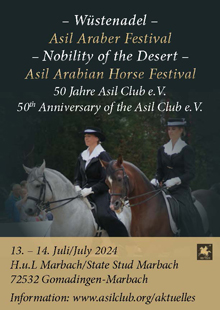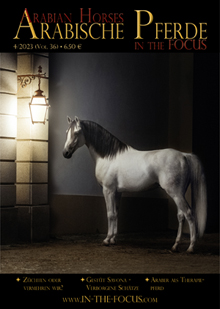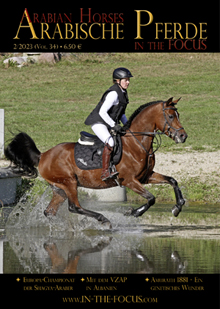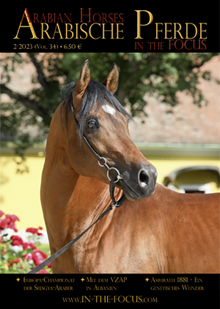Also during this season, 14 horses have perished virtually on the track at endurance rides in the Middle East. We have spoken with Ahmed Al Samarraie, longtime organizer of CEI 3* endurance rides, including an FEI Junior European Championship in Germany about the underlying reasons, what can be done about it, and what kind of effect
this scandal has, also in our region.
Arabian Horses IN THE FOCUS: Mr. Al Samarraie, your family is active in endurance riding already for many years. What were the biggest successes, that you could celebrate together?
Ahmed Al Samarraie: There were, for example, the Junior World Championships of our oldest daughter Joana in Pratoni del Vivaro 2003 and in Bahrain 2005, her German Junior Champion title in 2004, her victory in the Nations Cup of the CEIOJY 2004 and with it, Gold for Team Germany. The German National Champion title 2007 of my wife Klaudia with our first self-bred horse, Ayman, as well as the successful participation at the Senior European Championships 2011 in Florac with our self-bred Shagya-Arabian stallion Olymp. Then, of course, more recently the triple German Junior Championship titles of our second youngest daughter Moira and her successful participation in the Junior European Championships in Rio Frio 2016, all with our self-bred Shagya-Arabian mare Zarah, who was also elected “Arabian of the Year” in 2017. Then there was the German Vice-Champion title of our daughter Nayla with our self-bred Trakehner mare Famosa, which is owned by Gudrun Sauerbeck. And last, but not least, the highlight of last year was Nayla’s 14th rank at the Junior World Championships in Valeggio with our self-bred mare Warsana AA.
AH: Due to their successes in endurance, your daughters were invited several times for the “HH The President of United Arab Emirates Endurance Cup” in Abu Dhabi, just like this year your daughter Nayla. But she, or rather the whole team Samarra, has publicly turned down the invitation. What has happened?
A.A.S.: If you look at the development of endurance riding over the last few years, especially in the Arabian countries, then you can see, that the speed both on average as well as on the last loop has increased unbelievably. World records were set, even though there cannot be any world record in this sport because according to the rules, the trails have to be always different so that there cannot be any direct comparison. But the tracks for the desert rides became ever flatter and were always prepared in such a way, that they resemble race tracks. At these races, the horses are increasingly brought to and beyond their physiological performance limits, despite all training possibilities and veterinary assistance, which some of them – probably more than we know – pay with their lives. The most prestigious races, which are also the most sponsored ones, were developed into some sort of purchase event over the years, and at the same time, the organiser had the aim to improve his image. The invitation for the “best” riders of all – or at least of most nations –, and at the same time the request to give the purchase price when entering your horse, that you ‘ll bring along, speaks for itself.
In these races, we cannot see any sporting incentive and we do not want to participate in these spectacles, even though the experiences around these races could be interesting for our daughters. Our decision must also be seen under the aspect, that we – as a stud farm for many years in a country, where rather low prices are paid compared to our European neighbours – don’t want to sell any horses this way, nor do we make use of the possibility, to collect the “arrival bonus” that is being paid since recently. As far as I know, in January about 22.000 US$ were paid in Dubai, and now at the Presidents Cup in Abu Dhabi more than 30.000 US$ for any foreign starter who arrives in the ranking.
As we were approached by several people, also in social media, by email or by phone, whether or not we would follow this invitation, we have decided – also in order to be able to explain it – to make our rejection public, together with a clear statement. With his participation in such a private race, any participant accepts the event as is. We have been reproached, why then, we participated at the Junior World Championships in Valeggio. But to participate in a championship, also in an international one, is not possible for just anybody who could or wants to do this. Rather, one has to qualify with previous performance results and the respective National Federation (FN) of the country will nominate you. That’s quite a big difference, which we had to explain in the following discussion, as it was not clear to all.
AH: What exactly are “invitational races”, and what is the purpose to invite international riders for example for the “Presidents Cup”?
A.A.S.: With the invitational races the host pursues several goals. For one, he invites the most successful riders of almost all nations, which then becomes something close to a World Championship of its own. Their own riders measure themselves, so to say, with the “best riders” from all over the world, which was true in former years, although foreign horses always had the handicap of the long trip and most of the time also of the extreme change of climate. On the other hand, these races were always a shopping window of the endurance community, which became more and more professional, and which hoped for “big money” from the sale of a horse, which raced especially well. Today, this has become independent, and these races clearly are purchase races. The price quotation at entry is voluntary, but with these races, the hosts get delivered a lot of good horses virtually to the front door, which even has been tested by their participation before purchase. On the one side, this whole system weakens the competition, because the good horses don’t come home again, and then the athletes of these nations don’t have any suitable mount anymore. On the other side, the “drain” of good horses is significant, the next season is calling and one needs fit and highly talented horses, to achieve the next champion title, for which they almost have a subscription. A final effect is the hoped for and largely occurring image gain, supported by the big races in Europe, which attract riders with travel grants and arrival bonus. If many international riders participate in these races, then they will mostly talk about the perfect organization, the hospitality, and the great atmosphere – the downsides will be pushed back or even negated.
AH: Endurance riding has changed drastically over the last 10-15 years, among others, the motto “to arrive is to win” has been pushed more and more to the background. Today, the standard of all things seems to be speed, even here in Europe. In the Middle East, speeds of more than 40 km/h per loop have been reached, because finally (according to the FEI) an endurance ride is a “competition against the clock”. What’s going wrong here?
A.A.S.: Several things: Firstly, all the possible goals of this actually fantastic equestrian sports discipline have been reduced to the one and only goal, to become “first”. Additionally, the ongoing development of “ever faster” is detrimental to the “horse as a biological system” and demands a high price from our animal partners. Unfortunately, all this has already become reality, because these speeds are only possible, if – against the international rules – nearly 100 % of the tracks are prepared, permanent crewing is allowed, the incentive system is designed in a way, that “winning at all costs” becomes the highest goal and world records have been made possible. Flat stretches without any major changes of direction and surface create monotonous movements, permanent cooling with water deceives the metabolism of the horse and impedes body-specific early-warning systems. The accompaniment by the vehicles can be seen equal to “dragging”, which can manipulate a horse, too, because it follows the cars running parallel like it does with fellow horses in a herd. Not mentioning any veterinary help beyond any ethically acceptable limits during the training, as well as the unscrupulousness with which the best horses are used until they collapse during competition. In flat racing, there are no world records, but only a yearly winner, because an “ever faster” is not possible. As we could see in Boudheib competitions, natural trails – which are according to the rules – reduce the speed significantly and with it the risks for the horses – and yet, there are still winners.
AH: To what extent is the FEI complicit in this development?
A.A.S.: The FEI does not enforce its own rules. They allow world records to be declared, they do not regulate the necessary resting times for horses after they have raced at certain speeds. The FEI authorizes the introduction of a new competition class above the CEI 4* events – European and World Championships for Juniors and Seniors -, i.e. a new CEI 5* event, which will attract participants with high price money and just by that it can only be conducted by organisers which can afford themselves the minimum prize money of 50.000 CHF or more, or which have a respective sponsor. Behind it is the attempt to attract more media, which is compulsory for a 5* event, to get more publicity for the sport. Although this seems to be understandable, it is at the same time in the face of increasing incidents, very risky. In the field of tension between professionalism, which unfortunately is more and more equated with maximum profit orientation, and a growing number of nations, in which equestrian sports, namely endurance, is being practiced, business has seemingly won. The FEI could influence with other incentive systems this catastrophic development in a positive way, but she appears to be too week or too much guided by monetary goals, to really change anything. A weak system will always have participants that make use of these weaknesses.
AH: Also in Europe, there is a tendency towards ever flatter rides with straight tracks (e.g. Samorin, Pisa). What do you think of this?
A.A.S.: This is also the result of increasing influence by targeted sponsoring. Samorin had, in the beginning, several technically demanding sections with quite some elevation around Bratislava. With the European (2015) and World Championships (2016), these were changed on demand of the main sponsor of these FEI Championships, and more flat sections were selected. But the real problem is, that it is not possible there, to prepare a flat race track with sandy, consistent run. Rather, flat dirt roads with poor stony surfaces and rough asphalt roads, flat sandy tracks with holes in it, were combined, because it wasn’t possible otherwise. Abrupt changes of direction did the rest and therefore the running and the route was a considerable challenge, which caused many eliminations due to lameness, as well as a fatality. I was the commentator at the vetgate and I could see the horses myself, especially the exhausted and sometimes empty expression of most of the horses crossing the finish line among the first 10 to 15. As the FEI has given the next Championships in Europe to organizers who all have the same main sponsor, the next championships will also be run on flat, fast tracks. In Florac, but also in Marbach, other horses and riders would be in front. Here, the best teams were never faster than 20 km/h. The European Championships in Florac in 2011 were won with an average speed of 18,5 km/h.
Overall, one has to see this development very critically. For flat tracks, less equestrian skills (in the sense of quality) are required. The “durability”, i.e. the use of the horses over many seasons, has become shorter over the last few years, the number of fatalities is rising. Endurance riding is at least in some countries strongly criticized, even though the problems mentioned above do not actually exist in these countries, as we can see in Germany.
AH: At present, endurance rides are classified by their length, which means CEI 3* = 160 km, CEI 2* = 120 km, etc. Does this really make sense? Because it does not respect the topography and the surface of the track, although these are important criteria.
A.A.S.: The classification system is basically fine – one just has to abandon the prepared race tracks and to ban any world record, due to incomparability. Topography and surface, as well as the climatic conditions on the day of the ride, are the actual challenges. But because of the diversity of these parameters, ride categories and comparable ride lengths make sense as a constant.
AH: What effects do you see that comes from the sponsorship of European endurance rides by the Middle East?
A.A.S.: Basically, sponsoring over the past 20 years for endurance rides was mostly positive. The problem is the border crossing: The sports promotion, so to speak, became a “take over”. If at at the price giving ceremony of the Junior World Championships, which are an FEI event after all, only the first three are mentioned, and the winning team from the country of the main sponsor celebrates itself for 30 minutes, then this does not comply with what I would call a fair and for all appreciative competition. Especially, for these young riders the wrong signals are given. Furthermore, with massive sponsoring including travel grants and arrival bonuses, as we could see at some sponsored competition in Europe during 2017 and which have been already announced for 2018, big starter fields are generated. But this will take riders away from established rides, which are organized by several very active people in countries such as France, Belgium, but also in Germany, which resulted in 2017 in drastically reduced numbers of participants at various rides. Also, endurance riding as a sport will change with the influence of the sponsors also in Europe and become flat and fast races, which have nothing in common anymore with the challenge of a rider-horse team against a demanding technically challenging track. On top of that are the declining prospects for success, because only on technically challenging tracks riders of other nations have a chance to win. Above all, however, also in Europe more and more rider will train according to the motto “faster, faster”, which – as previously mentioned – is paid for by the horses.
AH: Now, one could say, the Middle East is far away, and nothing like that will happen in Europe. But the effects of this scandal are also felt in our country – in which way?
A.A.S.: It is the effects of the development, that we get to feel more and more. Dead horses can never be completely excluded in any Equestrian sport. Tragic accidents or unfortunate circumstances can always end deadly, as, for example, in 2006 during the WEG in Aachen, where we happen to be part of the German team, and a horse from Scandinavia got severe metabolic issues after only 10 km and had to be put down. That was not because of the type of race. However, what we cannot tolerate are the system-immanent fatalities: cannon fractures, splinter breaks, and heart failures. These are the consequences of physical stress way beyond the physiological limits of the animal’s life. This also causes considerable damage to the image of the endurance sport. Although, here in Germany, we have nothing to do with this type of sport, which is solely focused on speed, our endurance riders are discredited by other riders and parts of the public. Apart from the usual prejudices, that endurance riders cannot ride, and if so, only straightforward, we now have to face the accusation, that we have a sport in which horses die frequently. Although this is not actually the case in our country, it makes it difficult to get recognition for your achievements, to establish this fascinating equestrian sport, to get the normal sponsorship for national and international events and slows down the development of endurance riding in Germany, because young riders are being kept away.
AH: What kind of measures can be taken in our country? And how would you advise a breeder, who considers selling his endurance horse to a group VII country?
A.A.S.: I would wish for a clear statement of the FN and the VDD (German endurance riding association), an active search for co-operation with other organizations in other countries, such as Scandinavia, Switzerland and the US, and a common approach to the FEI. For breeders, who wish to sell their horses to a group VII country, I have no advice. In the end, everyone has to answer this for himself. Each individual has the freedom to decide, that’s also true for participating at invitational rides – and also here, one has to differentiate -, just like when selling a horse. Today, everybody can get information, if the prospective buyer has had any fatalities or if his records show frequently fast rides. The FEI has a publicly accessible database for each rider and each horse. Nobody can say, he didn’t know about it.
AH: Thank you for your clear words, and we wish you continued success for your horses and your family!
(the interview was conducted by Gudrun Waiditschka)













